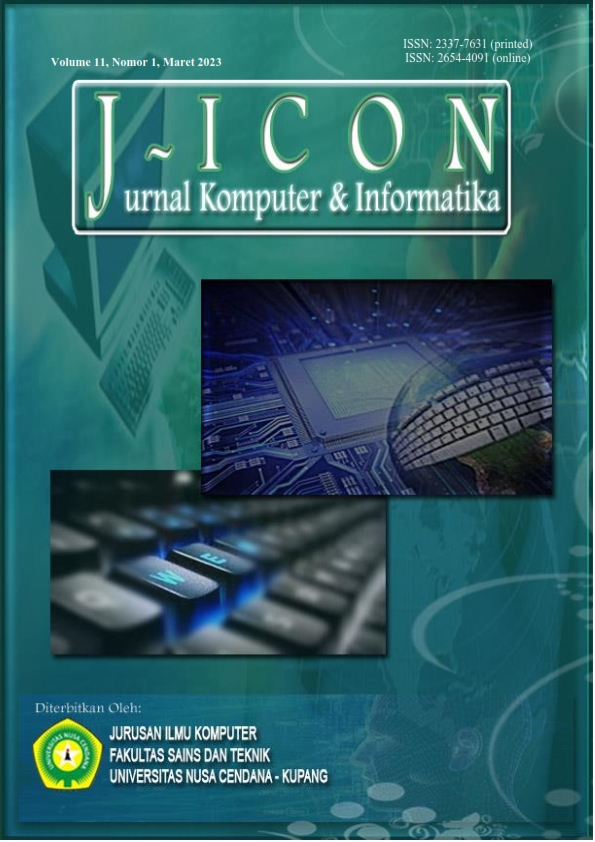ASPHALT ROAD DAMAGE DETECTION SYSTEM USING CANNY EDGE DETECTION
Abstract
Road is a means of access for humans to move from one place to another, connecting one place to another, and serving as transportation infrastructure. At all times, asphalt roads are passed by road users, including small, medium, and large vehicles. However, road conditions are not always smooth and often there are damages in certain parts of the road. Factors such as water, weather, temperature changes, unstable soil conditions, air temperature, poor compaction process on the base layer, and the weight or overload of heavy vehicles that exceed capacity, as well as the increasing volume of vehicles, can cause road damage. Road damage can reduce economic revenue and increase accident rates. Some types of asphalt road damage include undulating, potholes, cracking, and asphalt puddles on the road surface. Potholes are the most common type of damage that cause accidents for road users. This study uses the Canny edge detection method to detect asphalt road damage. The minimum object size that can be detected as road damage is 15x15 pixels and the maximum is 290x540 pixels. Testing was conducted on 65 primary data and 35 secondary data, and the average accuracy obtained were 90.5% and 88%, respectively.
Downloads
References
F. Yudaningrum and Ikhwanudin, “Identifikasi Jenis Kerusakan Jalan (Studi Kasus Ruas Jalan Kedungmundu-Meteseh),” TEKNIKA, vol. 12, no. 2, pp. 16–23, 2017, doi: http://dx.doi.org/10.26623/teknika.v12i2.638.
S. Nienaber, M. J. Booysen, and Rs. Kroon, “Detecting Potholes Using Simple Image Processing Techniques and Real-World Footage,” in South African Transport Conference, Jul. 2015, pp. 893–902, doi: http://dx.doi.org/10.13140/RG.2.1.3121.8408.
S. Pawade, B. P. Fuladi, and L. A. Hundikar, “FPGA Based Intelligent Potholes Detection System,” Int. J. Innov. Res. Comput. Commun. Eng., vol. 3, no. 3, pp. 2285–2290, 2015.
C. Suresh, S. Singh, R. Saini, and A. K. Saini, “A Comparative Analysis of Image Scaling Algorithms,” Int. J. Image, Graph. Signal Process., vol. 5, no. 5, pp. 55–62, Apr. 2013, doi: http://dx.doi.org/10.5815/ijigsp.2013.05.07.
L. Tonietto and M. Walter, “Morphing textures with texton masks,” in Proceedings. 17th Brazilian Symposium on Computer Graphics and Image Processing, 2004, pp. 348–353, doi: http://dx.doi.org/10.1109/SIBGRA.2004.1352980.
V. Sucharita, S. Jyothi, and D. Mamatha, “Evaluation of the Digital images of Penaeid Prawns Species Using Canny Edge Detection and Otsu Thresholding Segmentation,” Int. J. Emerg. Technol. Comput. Appl. Sci. (IJETCAS), vol. 6, no. 2, pp. 117–121, 2013, [Online]. Available: http://www.iasir.net/IJETCASpapers/IJETCAS13-526.pdf. [Accessed Mar. 24, 2023].
A. Greensted, “Otsu Thresholding,” The Lab Book Pages, 2010. [Online]. Available: http://www.labbookpages.co.uk/software/imgProc/otsuThreshold.html.
Z. Xu, X. Baojie, and W. Guoxin, “Canny edge detection based on Open CV,” in 2017 13th IEEE International Conference on Electronic Measurement & Instruments (ICEMI), Oct. 2017, vol. 2, no. 1, pp. 53–56, doi: https://doi.org/10.1109/ICEMI.2017.8265710.
K. A. M. Said and A. B. Jambek, “Analysis of Image Processing Using Morphological Erosion and Dilation,” J. Phys. Conf. Ser., vol. 2071, no. 1, p. 012033, Oct. 2021, doi: http://dx.doi.org/10.1088/1742-6596/2071/1/012033.
M. Králik and L. Ladányi, “Canny Edge Detector Algorithm Optimization Using 2D Spatial Separable Convolution,” Acta Electrotech. Inform., vol. 21, no. 4, pp. 36–43, 2021, doi: https://doi.org/10.2478/aei-2021-0006.
Copyright (c) 2023 Farhan Aditya Rafi, Adriana Fanggidae, Yulianto Triwahyuadi Polly

This work is licensed under a Creative Commons Attribution 4.0 International License.
The author submitting the manuscript must understand and agree that if accepted for publication, authors retain copyright and grant the journal right of first publication with the work simultaneously licensed under a Creative Commons Attribution (CC-BY) 4.0 License that allows others to share the work with an acknowledgment of the work’s authorship and initial publication in this journal.
 Farhan Aditya Rafi(1)
Farhan Aditya Rafi(1)




